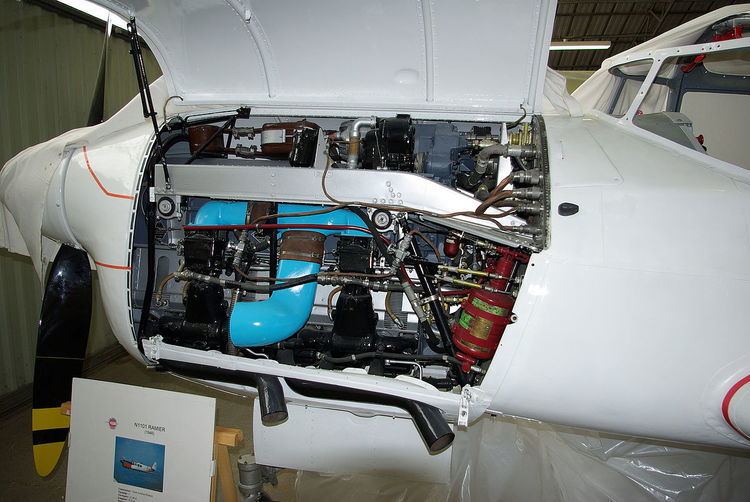The Renault 6Q is an air-cooled six-cylinder, inverted piston engine, producing about 160 kW (220 hp) continuous power. It was designed and built in France and produced for more than ten years after its homologation in 1936, with large numbers built during World War II.
Design and development
The six-cylinder Renault 6Q and the four-cylinder Renault 4P, both from the early 1930s, shared the same bore, stroke and pistons.
The 6Q was built in both unsupercharged and supercharged forms. The centrifugal supercharger was added at the back of the engine, driven off the crankshaft via step-up gearing. It added 13 kg (29 lb) to the weight and 242 mm (9.5 in) to the length but boosted the performance at altitude to a continuous power of 177 kW (237 hp) at 2,500 rpm and 2,200 m (7,220 ft). Two pre-war models were optimised to different altitudes, the 02/03 right- and left-handed pair to 2,000 m (6,560 ft), with 7.61:1 gearing and the 04/05 pair to 4,000 m (13,120 ft), with 12.274 gearing.
The 6Q was homologated in 1936; 1700 were built before the war and 1660 during it. Post-war, production was resumed. The majority of pre-war 6Qs were used in Caudron C.440 Goélands, during the war in Goélands and post-war in Nord's Messerschmitt Bf 108 derived Nord Pingouin, in the Nord Noralpha and Ramier Bf 108 developments.
Even sub-type numbers rotate clockwise, odd numbers anti-clockwise as seen from engine.
Renault 6Q-00/01Unsupercharged LH/RH rotation
Renault 6Q-02/03220 hp (160 kW) Supercharged to 2,000 m (6,600 ft) LH/RH rotation
Renault 6Q-04/05240 hp (180 kW) Supercharged to 4,000 m (13,000 ft) LH/RH rotation
Renault 6Q-06/07233 hp (174 kW) LH/RH rotation
Renault 6Q-08/09240 hp (180 kW) LH/RH rotation
Renault 6Q-10/11230 hp (170 kW) LH/RH rotation
Renault 6Q-18/19LH/RH rotation
Renault 6Q-20/21300 hp (220 kW) LH/RH rotation
Caudron C.440 GoélandCaudron C.631-5 SimounCaudron C.640 TyphonCaudron C.690Caudron C.860Dewoitine HD.730Farman F.430Hanriot H.230Morane-Saulnier MS.350Morane-Saulnier MS.501Nord 1101/2 Noralpha/RamierNord PingouinPotez 661Rey R.1SNCASE SE-700SNCASE SE-1210Ailes Anciennes, Toulouse: Renault 6Q 10 in a Nord 1101 Ramier I.Data from Jane's All the World's Aircraft 1948, p.55d
Type: 6-cylinder inverted air-cooled inlineBore: 120 mm (4.72 in)Stroke: 140 mm (5.51 in)Displacement: 9.5 l (580 cu in)Length: 1,600 mm (63.0 in)Width: 510 mm (20.1 in)Height: 920 mm (36.2 in)Dry weight: 240 kg (529 lb) dryValvetrain: One inlet and one exhaust valve per cylinder with Austenitic, driven via tappets, rocker arms and pushrods from a camshaft in the crankcase.Fuel system: Twin Zenith carburetters and SEV ignition magnetos; two sparking plugs per cylinder.Oil system: Dry sump with pump to crankshaft, camshaft and big ends. Cylinders and pistons splash lubricated.Cooling system: AirCylinders: Steel barrels with machined fins aluminium heads with cast fins and hemispherical combustion chamber.Pistons: Aluminium alloy forged with four piston rings and floating gudgeon pins. Duralumin connecting rods with white metal big-end bearings and bronze little-end bushes.Crankshaft: Forged steel with six throws and seven bearings.Crankcase: Aluminium, with magnesium cover and main bearing in crankcase extension.Power output: Take-off 174 kW (233 hp) at 2,500 rpm; normal 163 kW (218 hp) at 2,500 rpm and 500 m (1,640 ft)Compression ratio: 6:1
